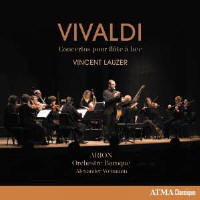Texte paru dans: / Appeared in: |
|
|
Reviewer: Bertil
van Boer
The debate in Vivaldi over
transverse flute or recorder is sometimes not easily settled, particularly
since the ranges and technical demands overlap to a large degree. This being
said, this Canadian recording uses the recorder in all of its glory. These
works have often been recorded before both on modern and period instruments,
and Vivaldi’s music is flexible enough to accommodate the timbres and
flexibility of both. Here, however, we have a rather nice set of works that
are impressively performed and interpreted.
The opening is the famed
“piccolo” concerto with its twirling roulades in the solo outer movements.
Vivaldi originally meant for this to be an “ottovino,” sometimes
reinterpreted as a “flautino” or little flute. Today we translate this as
piccolo, but in his time it was perhaps not quite as well defined, meaning
some sort of very high-pitched instrument, either a sopranino recorder or
perhaps one of the smaller transverse flutes that Johann Joachim Quantz
defines. In any case, it is meant to whirl about in the uppermost registers,
but where Vivaldi really shines in this work is in the second movement, a
slow lament aloft from a steady-paced ostinato accompaniment. In the G-Minor
Concerto, subtitled “La Notte,” we have a sort of dramatic sequence that
opens with a French style set of powerful unison dotted rhythms before
running amok in a set of swift sequences and scales. The third section, a
Presto, is almost a tempest, while the finale begins with a slowly unfolding
harmony that seems evocative of moonrise, gentle and mysterious. The finale
is at Vivaldi’s usual frenetic pace, with the alto recorder whipping about
through the sequences. In the C-Minor Concerto (RV 441) we are thrown into
the more spacious Baroque world of Bach, with a set of longer lines that are
spun out in the opening ritornello, but when the solo enters there is a
flurry of virtuosity with some technically challenging passages. The second
movement quite French in style with dotted rhythms introducing a more
mournful lyrical recorder line. The finale is more solemn than one might
expect, spun out longer and with some interesting rhythmic duplication
before the extremely virtuoso arpeggiated figures in the recorder. Of
particular interest in the F-Major Concerto (RV 442) is the slow and stately
Siciliano second movement, while the C-Major finale (RV 444) has a joyous
and almost galant moment with its bright trills and use of the extreme
range. The only oddity is the F-Major Concerto (RV 312R) which is a modern
arrangement of a violin concerto. I suppose this was added to fill out the
disc, and while the arrangement seems suitable for the recorder, it doesn’t
really add to the canon for the instrument. There has been some discussion over the past several years regarding HIP performances, particularly whether one ought to use an “orchestra” of one instrument per line or a larger ensemble. Here, the Arion orchestra uses a rather more traditional approach, with 4–3–2–2–1 for the strings, lending the violin sound not quite the robustness of a larger number but not as spare as one-on-a-part. Going back to Quantz’s recommendations, this seems about right for the textures and necessity of accompanying the often shrill recorder. Of course, the continuo group also includes an archlute and guitar to reinforce but not overwhelm those softer passages where the harpsichord might seem a bit too forceful. In any case, the sound is clear and with just enough depth to provide an excellent rendition of Vivaldi’s often subtle orchestration. As for the playing of Vincent Lauzer, it is universally excellent, with just the right amount of ornamentation and a good sense of phrasing. He moves easily between the various recorders without breaking a sweat. In short, while there are plenty of recordings out there, you should check this one out for its lively and often joyous performance. | |
|
|
|
|
|
|
|
Cliquez l'un ou l'autre
bouton pour découvrir bien d'autres critiques de CD |
|




